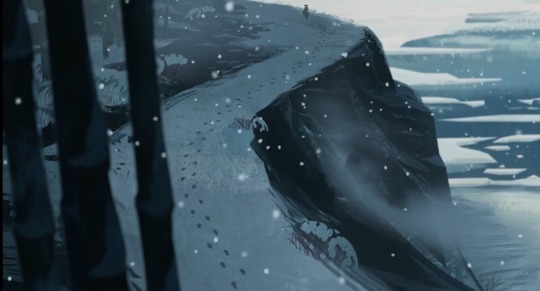#edo era
Text
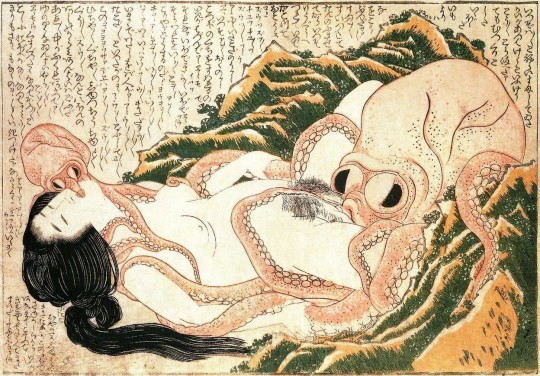
Katsushika Hokusai (1760-1849) — The Dream of the Fishermans Wife [woodblock print, 1814]
627 notes
·
View notes
Text

Edo period types of hakama pants, fantastic chart by Edo-lover Nadeshico Rin. You can see here from left to right, top to bottom:
Fundomi hakama 踏込袴 - pants with a narrow bottom hem, a type of nobakama (see below)
Tattsuke hakama 裁付袴 - pants tight below the knee, sometimes refered as "ninja pants" (= Iga hakama). Those were worn by many, from samurai to servants and craftmen.
Umanoribakama 馬乗袴 - lit. "riding pants", wide hakama with high gusset split legs for confortable horse riding.
Nagabakama 長袴 - formal trailing hakama worn by samurai from late Muromachi era.
Andonbakama - skirt-like hakama worn by Meiji period female teachers and students (hence why it's sometimes called onna bakama). A boy version appeared after mid-Meiji.
Yamabakama 山袴 - daily-life work pants with narrow legs and sometimes a gathered bottom hem. Name greatly varies depending on areas and time. A direct descendant of this style are women's monpe もんぺ.
Nobakama 野袴 - shorter hakama with black velvet hem, worn by travelling samurai. It was also part of firefighters' gear.
Hirabakama 平袴 - the "classic" ankle lenght men hakama pants, with a low gusset which means it looks nice when sitting (tailoring is hence different from the umanori, see above). Also called hanbakama 半袴, those were longer than the ancient kobakama 小袴 and shorter than formal trailing nagabakama (see above).
#japan#historical fashion#fashion history#ressources#hakama#hakama pants#references#edo period#edo era#nadeshico rin#Fundomi hakama#Tattsuke hakama#Iga hakama#Umanoribakama#Nagabakama#Andonbakama#Yamabakama#monpe#Nobakama#Hirabakama#hanbakama#kobakama#japanese pants#着物#袴
1K notes
·
View notes
Text

Fireflies in the Early Summer by Watanabe Shoka (19th Century)
#watanabe shoka#art#ukiyo-e#woodblock prints#fine art#19th century#19th century art#edo era#edo period#woodblock print#japanese art#japanese artist#nature art#fireflies#insects#summer#asian art#classic art
3K notes
·
View notes
Text


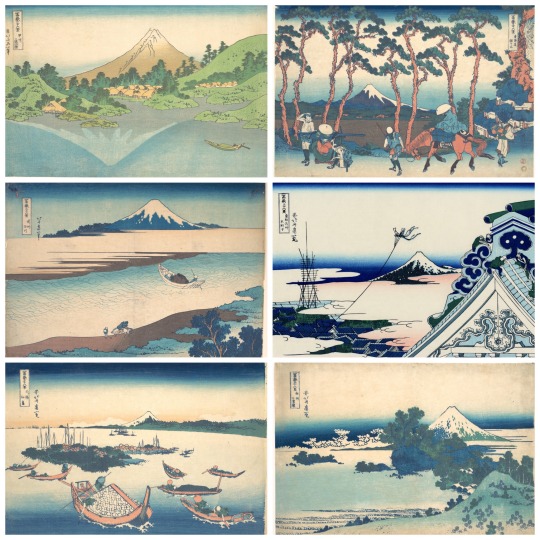
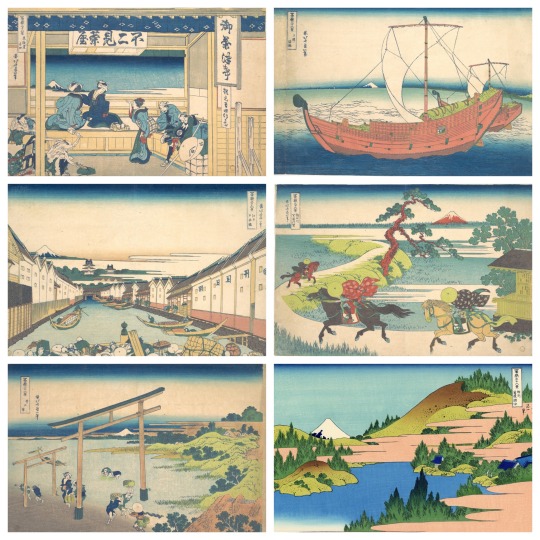
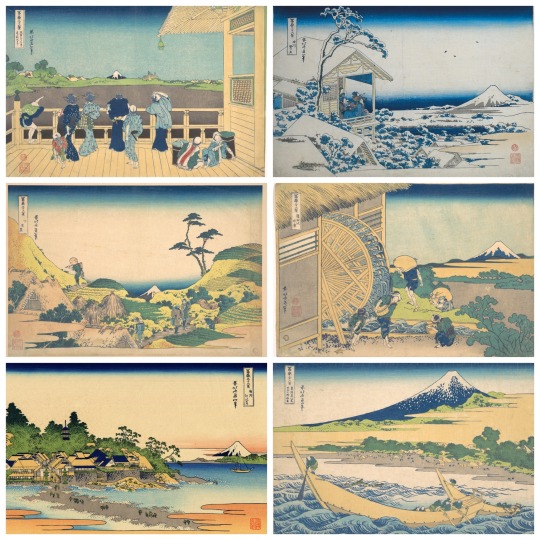
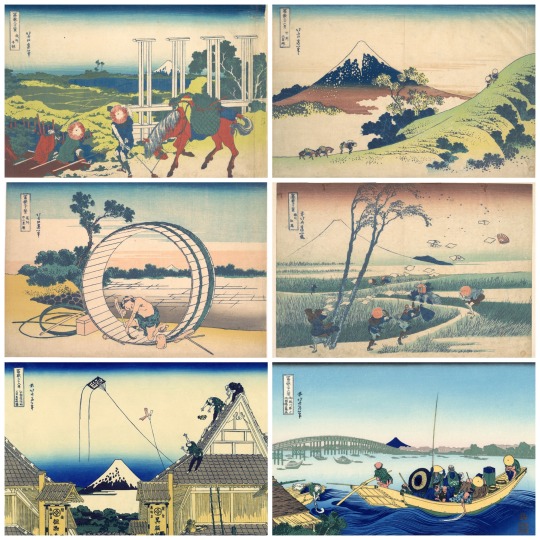
Katsushika Hokusai
Thirty-six Views of Mount Fuji (details)
c. 1830-1832
#hokusai#japanese woodblock#mt. fuji#woodblock print#japanese print#japanese art#japan beauty#japanese prints#print making#asian art#art history#the great wave#katsushika hokusai#woodblock art#woodcut#edo era#edo print#edo period#japan#japanese#japanese history#japanese artist
371 notes
·
View notes
Text


Robe (Kosode)
Early 17th Century
This sumptuous robe is among the earliest extant kosode (garment with small sleeve openings). The natural scenery of Japan’s coast, with its beaches strewn with shells and sea grass, inspired the delicate embroidered design. The foundation fabric, woven in an intricate key-fret pattern with floral motifs, was likely imported from China in its white, undecorated state. It was then resist dyed to achieve the effect of irregular sandbanks, and the marine motifs were embroidered on top. The alternating bands of light blue were further embellished with gold-leaf accents.
The MET
#robe#kosode#fashion history#japanese fashion#non western fashion#historical fashion#17th century#off white#japan#embroidery#edo period#edo era#1600s#1610s#1620s#1630s#the met
284 notes
·
View notes
Text

An early example of Irezumi tattoos, 1870s
#japan#japanese art#japanese photography#yakuza#meiji era#edo era#edo period#meiji period#samurai#tattoo#tattoos#irezumi#traditional tattoo#stick and poke#handpoke
295 notes
·
View notes
Text

A Nagasaki black lacquer on metal and aogai inlaid lidded box. Around 1805
Portrait of Napoleon after Louis Leopold Boilly, showing the young Napoleon as the first consul of the French Republic in 1802.
(Lempertz)
#he’s looks so done haha#napoleon#napoleonic era#napoleonic#napoleon bonaparte#first french empire#french empire#19th century#history#auction#Lempertz#box#artifact#french republic#first french republic#french revolution#art#Louis Leopold Boilly#Louis-Léopold Boilly#Boilly#Asian art#Japanese art#edo#edo period#edo era#Japan
35 notes
·
View notes
Text

New OCs (maybe? one is based on a real person) done during my history class yesterday because I'm obsessed with Oiran/Samurai relationships
#oiran#tayu#feudal japan#samurai#character design#ocs#my ocs#idk right now#tokugawa shogunate#edo era#meiji era#my art#concept art
34 notes
·
View notes
Text
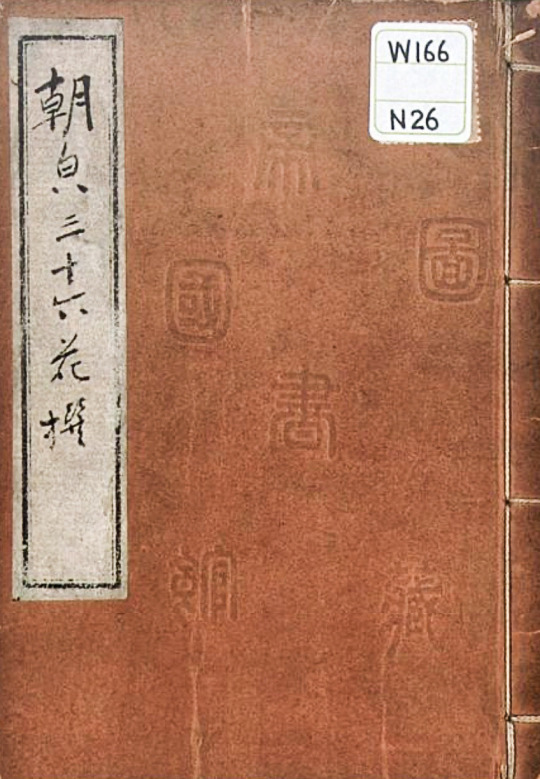
[MORNING GLORY BOOK] by Bankaen Shujin [aka Yokoyama Masana] (1954). Illustrated by Hattori Sessai.
This pictorial book from 1854 is known as one of the best books on morning glories published in Japan. It reflects the morning glory mania that began in 1847 and that was widespread among the people of Edo (present-day Tokyo) at that time. The book features colored prints of 36 morning glory flowers and leaves with strange shapes, by Hattori Sessai (1807-?), a Japanese painter known for his naturalist works. The descriptions were written by Bankaen Shujin, also known as Yokoyama Masana (1833-1908), who was a retainer of a Tokugawa shogun.



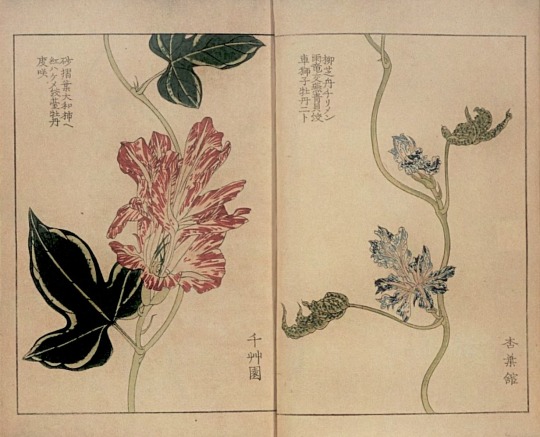
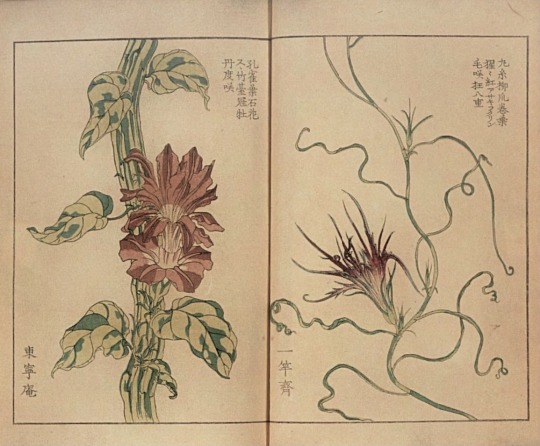




source
#beautiful books#book blog#books books books#book cover#books#illustrated book#vintage books#gardening#morning glory#japan#biological diversity#edo era#book binding
138 notes
·
View notes
Text
Have a happy caturday 😺🐾🐾❣️
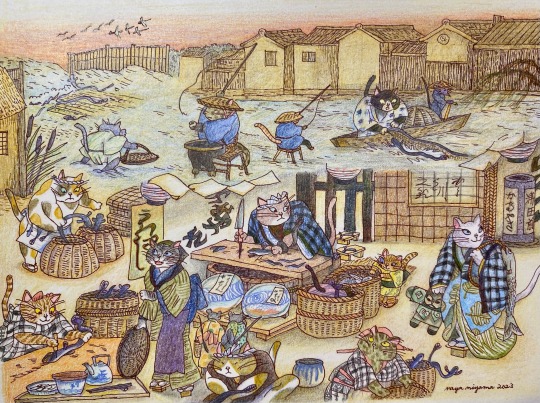
#maya miyama#illustration#caturday#cat#catlover#catlife#catinstagram#eels#eelsshop#edo#edo era#江戸時代#鰻屋#うなぎ#鰻
43 notes
·
View notes
Photo
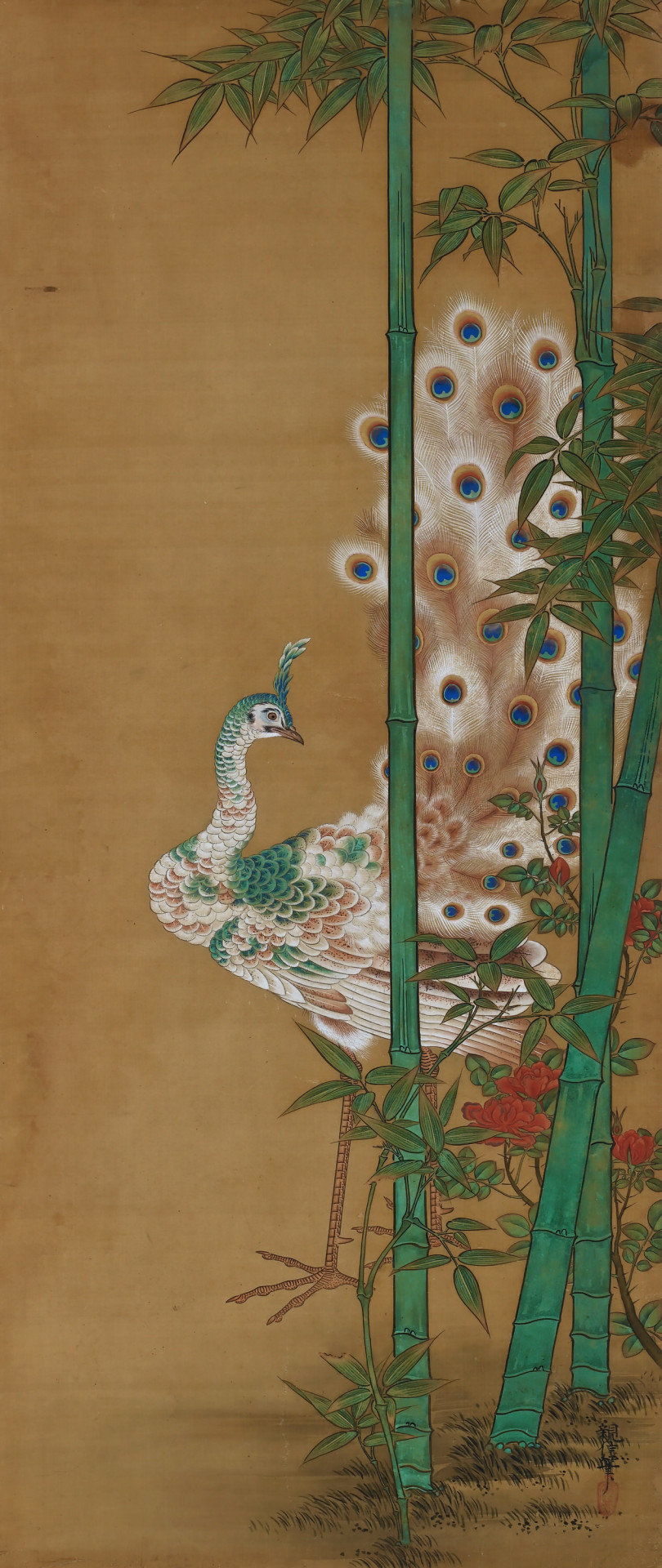
Kanō Chikanobu (1819-1888) — Peacock and Bamboo [ink, pigment and gofun on silk, ca. 1850]
560 notes
·
View notes
Text


Samurai's ranks and dress code in Late Edo period
AMAZING reference chart put together by Nadeshico Rin, showing the different attires worn by the men of the buke class in and about Edo Castle. OP stresses the chart is by no means exhaustive - but it helps picturing things SO MUCH!
For easier reading, I have adapted the chart with english translation. Rin has also created illustrations detailing each attire, I'll translate those in coming days under the tag "samurai kimono".
You'll find the transliteration below cut:
The court ranks - Mibun 身分 or Ikai (位階)
Find more about the exact titles here.
一位 Ichii (First court rank)
三位 Sanmi (Third court rank) and 四位 Shii (Fourth court rank)
Goi 五位 (Fifth court rank)
Omemie ijô 御目見 以上, the "upper" vassals allowed to request audience with the shogun
Omemie ika 御目見 以下, the "lesser" vassals (not allowed to request audience with the shogun)
Rin does not mention the second court rank (二位 Nii) so I am not sure where this one is supposed to go ^^;
The clan/families - Kamei 家名
徳川将軍家 Tokugawa shôgunke (Tokugawa Shogun clan)
尾張徳川家 Owari Tokugawake (Owari Tokugawa clan), 紀伊徳川家 Kii Tokugawake (Kii Tokugawa clan), 水戸徳川家 Mito Tokugawake (Mito Tokugawa clan), 徳川御三卿 Tokugawa gosankyo (Secondary Tokugawa branch clans: Tayasu, Shimizu, and Hitotsubashi)
三奉行 Sanbugyô, & 下三奉行 Shimosan bugyô (magistrates, governors)
旗本 Hatamoto (general term for upper-rank vassals of the Tokugawa)
御家人 Gokenin (general term for lower-rank vassals of the Tokugawa)
Outfits TPO (Time, Place, Occasion)
第一礼服 (大礼 など) Daiichi raifuku (tairei nado) - Most formal outfit worn during State/important ceremonies, etc.
礼服 (正月など) Raifuku (Shogatsu nado) - Formal outfit, worn for events like New Year, etc.
通常礼服 (節句など) Tsûjô raifuku (sekku nado) - Regular
formal outfit, worn during seasonal festivals, etc.
平服 Heifuku - Everyday outfit
Type of outfits
Rin has released separated charts detailing the different costumes. You'll find them translated here in coming days.
束帯 Sokutai - old ceremonial court dress, first worn by Heian nobility. Attire includes the 笏 shaku (flat ritual sceptre), and 冠 kanmuri hat.
衣冠 Ikan - old ceremonial court dress, much more simpler than sokutai
布衣 Hoi - "plain" 狩衣 kariginu (which were informal clothes worn by the nobility from the Heian period and onwards)
素襖 Suô - ceremonial dress of the lower-ranked samurai
直垂 Hitatare - ceremonial court robe
狩衣 Kariginu - patterned kariginu (informal clothes worn by the nobility from the Heian period and onwards)
大紋 Daimon - 直垂 hitatare with large family crests
直衣 Nôshi - everyday robes which were first worn by males of the imperial family during Heian era, and then spread among nobility, etc.
長上下 Naga Kamishimo - outfit pairing a sleeveless ceremonial robe called 肩衣 kataginu, with trailing pants called 長袴 nagabakama
半上下 Han Kamishimo - outfit pairing a sleeveless ceremonial robe called 肩衣 kataginu, with ankle lenght pants called 半袴 hanbakama
#japan#history#fashion history#samurai kimono#samurai#nadeshico rin#edo era#edo period#shogun#tokugawa#ressources#references#Sokutai#Ikan#Hoi#Suo#Hitatare#Kariginu#Daimon#Noshi#Kamishimo#nagakamishimo#hankamishimo#kataginu#hakama#nagabakama#hanbakama#court rank#buke#warrior class
742 notes
·
View notes
Text
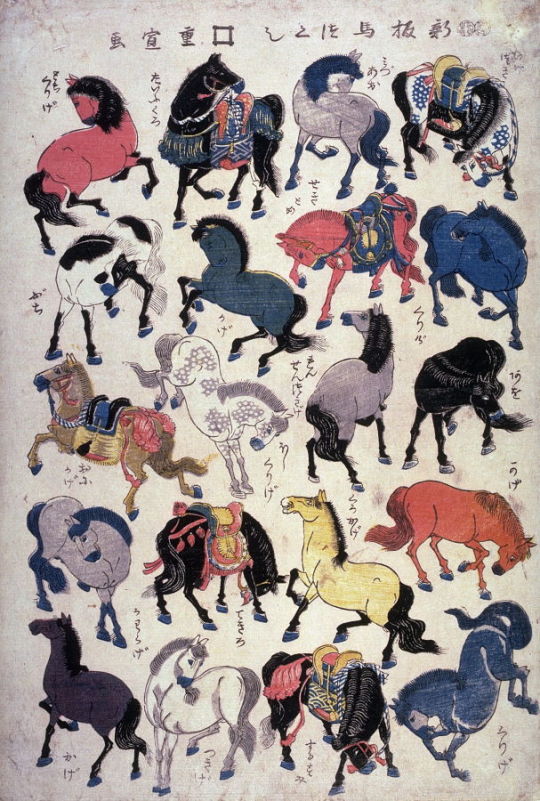
Horses, A New Publication by Utagawa Hiroshiage II (1847-48)
#utagawa hiroshige#art#ukiyo-e#woodblock prints#fine art#19th century#19th century art#edo era#edo period#woodblock print#japanese artist#japanese art#nature art#animals#horse#horses#asian art#classic art
5K notes
·
View notes
Text
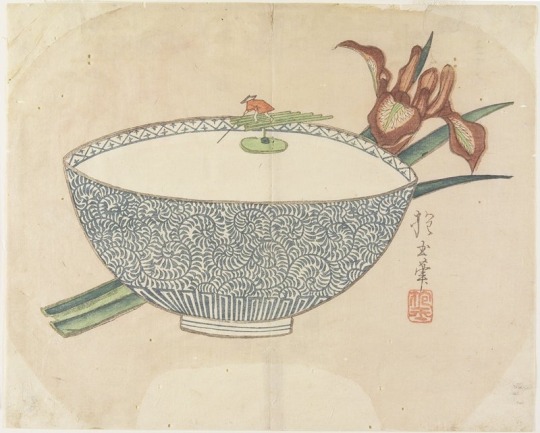
Yamada Ho_gyoku
Bowl of Water with Tiny Boatman Floating (uchiwa-e)
c. 1830
#yamada ho gyoku#woodblock art#woodblock print#japanese prints#japanese art#japanese#paddle fan design#japanese fan#japanese woodblock tradition#japanese woodblock#woodcut#uchiwa-e#edo japan#edo art#edo print#edo era#edo period
164 notes
·
View notes
Text

Arikoto from Ooku because this fandom needs more content.
Watercolor made by me.
#ooku#ooku the inner chambers#ooku: the inner chambers#arikoto#madenokoji arikoto#arikoto my darling#arikoto madenokoji#anime#netflix#fanart#anime fanart#my art#Ōoku#大奥#fumi yoshinaga#watercolor#watercolor art#japanese culture#japan#edo era#watercolour art#watercolourpainting
46 notes
·
View notes
